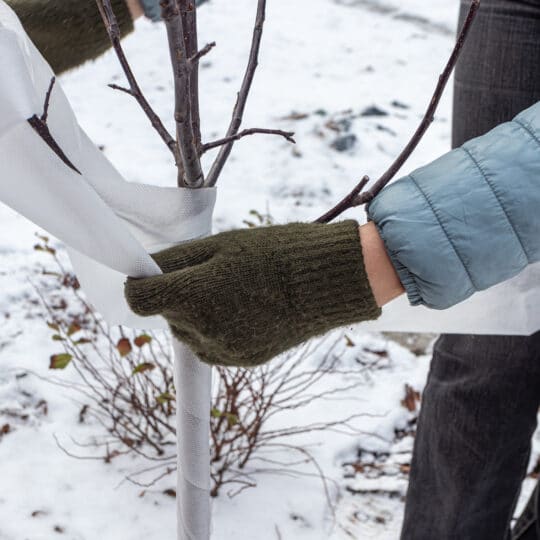Wrapping Trees in the Winter
The Process and Benefits
Posted
January 9, 2025

Strong, healthy trees and shrubs are supposed to be able to stand up to harsh winter weather. However, some are more prone to various conditions that can harm them this time of year. Learn the benefits of tree wrapping and how it can help vulnerable plants make it through the season.
Wrapping Material and Process
Just as we wrap ourselves in a coat and scarf to block the cold, some trees and shrubs benefits from a wrap to help protect their branches and bark. Different types of material are used for this process, but they should all be light in color to reflect sunlight. Here are some wrapping options:
- Polypropylene. This stretchy fabric allows for a secure wrap.
- Paper. Features an asphalt-based adhesive material between layers of craft-like paper.
- Burlap. This durable, woven fabric is made of natural fibers.
- Tree guards. Provide the same benefits as a wrap, but in a tube design that’s placed around the trunk.
Here’s how to apply the wrap:
- Start at the bottom of the trunk
- Wind material around the base working in an upward angle. Make sure the wrap is snug but not too tight.
- Overlap slightly as you move up the trunk.
- Wrap until you’ve reached the lowest branch.
- Secure it at the top by tucking it in. Avoid using wire ties or anything that could cause girdling.
Since the wrap is designed to protect the bark from extreme temperatures and potential damage, it’s typically applied in the late fall before the first frost and should be removed after the last frost in the spring. Leaving the tree wrapped for too long gives insects a place to hide and becomes an ideal environment for mold growth which causes even more damage.
Shrubs and Tree Wrapping Benefits
Young trees and shrubs with soft bark are more prone to winter damage. Wrapping works to protect the tree against winter weather, pests, and injury. Here’s how.
- Trunks wrapped in the fall are protected from lawn care machinery, such as mowers, trimmers, and aerators.
- Prevent sunscald throughout the winter. This happens when intense sunlight warms the trunk during the day, trigging the bark to break dormancy. But when the temperature suddenly drops at night, the active growth shuts down, leaving behind sunken and discolored bark.
- Block wood-boring insects.
- Shield the bark from squirrels, rabbits, and deer that may nibble the tender bark of your unwrapped tree.
Not all trees and shrubs need wrapping. If your plants are older and established, they can survive the winter without bundling up. If you’re not sure which species will benefit or not, contact the specialists at Cardinal Lawns. We know which types of plants can thrive in our local growing zone, and which need a little help surviving the season.

Download Your FREE Summer Plant Care Guide
Help your plants make it through a hot & dry summer looking like a million bucks with our summer plant watering and maintenance guide!